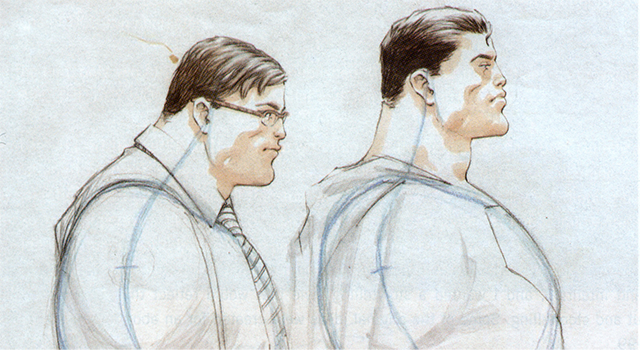You are likely thinking the same thing I was when I first saw some of the early playthroughs of Hitman: there is no freaking way that those disguises would ever work. Look at Agent 47, the player character of the game. It’s perfectly obvious who he is. There is no way a bald white guy with a shiny dome and a bar code on the back of his head would be able to go unnoticed anywhere, let alone a facility that’s supposed to be secure.
I especially had trouble believing that it would be possible for people not to recognize a suspicious person in the crowd, even if they were wearing an outfit of a worker. I fall into a category of people that the University of Greenwich calls a super recognizer. (I know; I’d have come up with a better name, too.) People in this category can remember about 80% of faces after only a glimpse, where most people only remember 20%. UoG has a test that you can take to see if you fall in this category. However, there are some people who fall on the complete opposite of that spectrum.
With the second episode of Hitman dropping on April 26th, I think now would be a great time to science the shit out of Hitman disguises.
There are three factors of human nature that work in favor of the Hitman disguises. As in the game they aren’t 100%, but they work well enough to allow the Agent 47 to slip into most situations unnoticed. The first is simply facial recognition. The second is is what I like to call the Superman effect. And lastly, there is the Authority Principle.
Prosopagnosia
Some of you might know what that big word is, but just in case you don’t, it’s a genetic disorder that inhibits a person’s ability to recognize faces. It’s a real thing. A writer at Cracked made a nice little illustration about how it works because most people say that it’s impossible to not recognize faces of people. They are so different from each other.
Well, the author of the article suggests that we take a pile of LEGOs and drop them on our desk, look at them for five seconds, turn away, then describe the LEGOs in full detail: color, order, and shape. You can try it with the picture below.

It’s nearly impossible, right? Well, this is the same principle that one in 40 people suffer from. Many with prosopagnosia don’t even know it. However, that’s not a high enough percentage for it to work as well in Hitman, so we have to turn to other factors of facial recognition.
I don’t know if you’ve watch the National Geographic show Brain Games, but it’s great and is currently on Netflix. I was watching it the other day, and it showed a picture of former President George Bush and former VP Dick Cheney. In fact, you can see the picture below. The narrator asked us to name the two people in the picture, and since the handful of people in the room had all been alive in the early 2000s, we knew immediately who they were.

However, as it turns out most of the people in the room were wrong, just as you’re probably wrong right now. What if I told you that both faces in that picture are of the same person; would you believe me without looking back up at the picture? Well, since you’re probably looking back up at the picture now, I can tell you that the image is actually Photoshopped so that both men in that picture bear George Bush’s face. The one on the left is just covered with glasses and the skin tone has changed to better fit Cheney’s skintone. Check for yourself, if you haven’t.
Remember this phenomenon. We’re going to come back to it.
The Superman effect
We all think that Clark Kent’s disguise is horrible, right? It’s just a set of glasses. But it’s really more than that. The glasses help, but he also has a different hairstyle and is approximately three inches shorter. The illustration above shows best what I’m talking about. But the biggest thing that Clark Kent has going for him is his job.
Going back to the prosopagnosia story, the author tells us about a time where she was in the bathroom complaining to a woman how boring one of her professors was. She went on for minutes, and the other woman was horrified. As it turns out, the woman she was complaining to was the same woman she was complaining about.
Of course, most of us would not have that exact story, but we can sympathize because the reason that she wasn’t recognized goes beyond prosopagnosia. The major factor was the woman’s location. She wasn’t recognized as the professor because she wasn’t in the classroom. I can profess that I have run into people in the grocery store or someplace out in public and didn’t recognize them immediately because they were out of the normal element.
Our brains fill in the blanks. We expect a certain thing to be a certain way, and we will make it fit that mold. The best demonstration of this can be illustrated with words.
Wehn the cneetr of wrods are celmetpoly jbeumld up our biarns wlil alumatiatocly put tehm in the rgiht odrer wutoiht mcuh efroft. You hvae vrey ltlite tbulroe rnedaig tihs paagrprah, rhigt?
Beyond the forced clumsiness, glasses, and slouch, no one expects Clark Kent to be at the daily planet, just as no one expects an assassin to be the man serving drinks or fixing the plumbing like in Hitman. So our brains just fill in the blanks, which can sometimes keep us from recognizing faces that we should.
Authority Principle
The Authority Principle simply states that if you project authority in dress and mannerisms, then you will likely be given that authority. In other words, the uniform makes the man. In a 2011 study regarding police uniforms, participants were asked about their feelings regarding the police uniform and what it represents. It was a tightly controlled and diverse study.
This study wasn’t perfect, but there were two major things that can be taken from this study for our purposes. First, uniforms project a sense of authority. A police uniform projects respect of its station, fear, or disdain depending on the viewer — regardless, it projected an authority figure. Secondly, it created anonymity because everyone tends to look the same when wearing a uniform. Although this study was based on police uniforms, the principle applies to all uniforms.
Let’s put this all together
In episode one of Hitman, Agent 47 is tasked with taking out a man on board a boat where a party’s taking place. To get on board the ship, he subdues a mechanic. He is able to walk around in that man’s uniform in most places, demonstrating the authority principle. However, he cannot go other places on the boat without being noticed because he would seem out of place, the reverse of the Superman effect. But when he is dressed as the bartender, he is able to serve drinks and even get close enough to hear his target talking to another man, the Superman effect in full.
During this whole process, he passes many people who see him in both uniforms, but don’t think anything of it. Of course, they don’t have prosopagnosia, but they demonstrate how difficult it is for people to distinguish faces. In fact, the game actually does a great job at representing this by having only a handful of people who would even know that you shouldn’t be wear the uniform you’re wearing.
But this is science, and science wouldn’t work if it couldn’t be proven wrong. Let me know your thoughts in the comments below. Am I right? Am I wrong? I’d like to know your opinion. What have you seen or read regarding this situation? Let me know all your thoughts in the comments below.
Also let me know if there is any video game trope you’d like me to science the shit out of. I will do my best to fit it in a future article. See you next time!








Published: Apr 21, 2016 09:42 am